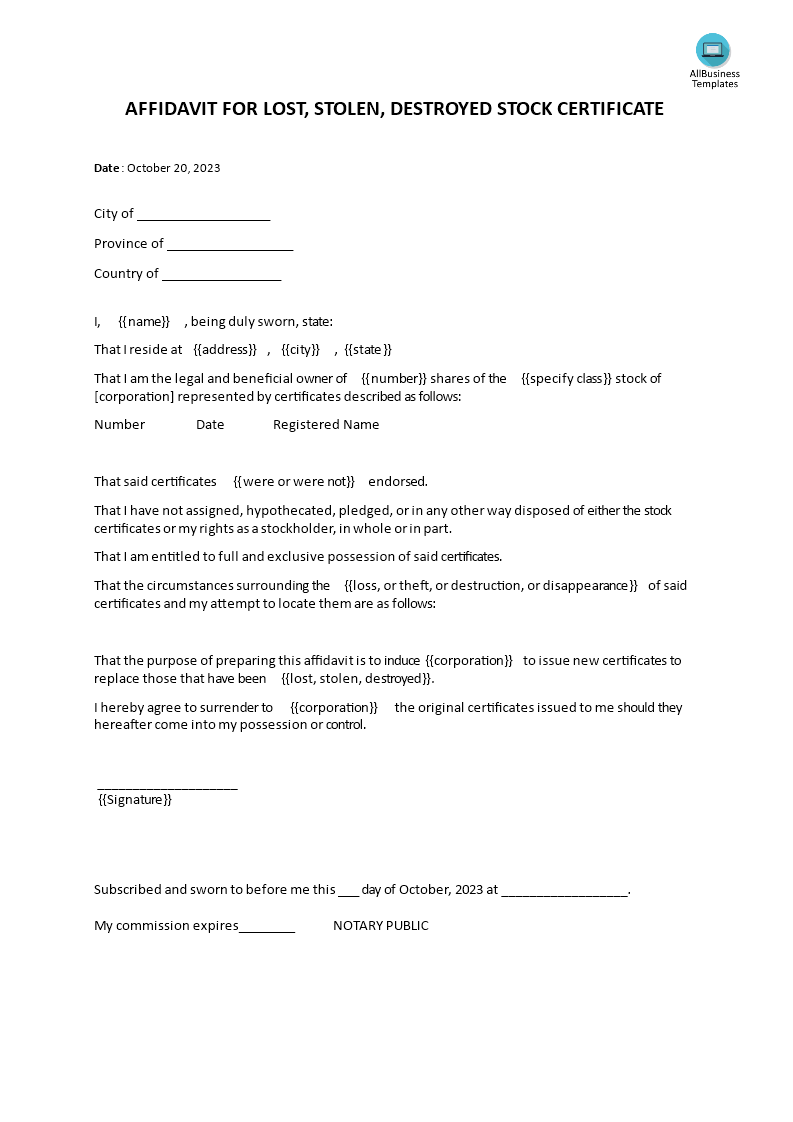Affidavit For Lost or Stolen or Destroyed Stock Certificate
Save, fill-In The Blanks, Print, Done!

Download Affidavit For Lost or Stolen or Destroyed Stock Certificate
Today: USD 1.99
Download It Now

Available premium file formats:
Microsoft Word (.docx)- This Document Has Been Certified by a Professional
- 100% customizable
- This is a digital download (23.67 kB)
- Language: English
- You will receive a link to download the file as soon as your payment goes through.
- We recommend downloading this file onto your computer.
Do you need an Affidavit of loss for a stock certificate? What is the procedure for writing an affidavit of lost certificate? Our Affidavit For Lost Stock Certificate template can help protect you from legal risks that may arise from the loss of a stock certificate. It is fully customizable and easy to follow, making it the perfect solution for your business. Download it now to get started!
Writing an affidavit of a lost certificate involves creating a legally binding document that provides details about the loss of a valuable certificate, such as a stock certificate or a diploma, and formally declares the loss. This affidavit serves as a sworn statement under oath, attesting to the circumstances of the loss and the intent to request a replacement certificate. Below are the steps to help you write an affidavit of a lost certificate:
Step 1: Format and Heading
- Begin the affidavit with a title such as "Affidavit of Lost Certificate."
- Include the name of the affiant (the person making the affidavit) and the affiant's address.
- State the jurisdiction or court where the affidavit is being made. For example, "State of [State] County of [County]."
Step 2: Introduction
- Start with a clear introductory statement, such as: "I, [Your Full Legal Name], being of lawful age, do solemnly swear and affirm the following under penalty of perjury."
Step 3: Statement of Lost Certificate
- Describe the certificate that was lost, including details such as its type, certificate number, issue date, and any unique identifying information.
- Explain how the certificate was lost, including the date and location of the loss.
Step 4: Statement of Ownership
- Confirm your ownership of the lost certificate. State your name as it appears on the certificate, and declare that you are the lawful owner of the certificate.
Step 5: Request for Replacement Certificate
- Clearly state your request for a replacement certificate to replace the lost one.
- Specify whether the replacement certificate should be issued with the same details as the lost certificate, including the same name, date, and any other relevant information.
Step 6: Indemnification Clause
- Include an indemnification clause to protect the issuing authority (e.g., the certificate issuer, a university, or a corporation) from future claims or liabilities related to the lost certificate. This clause typically states that you agree to indemnify and hold the issuer harmless from any losses or legal actions that may arise due to the issuance of the replacement certificate.
Step 7: Notarization
- Leave a space for your signature and the date. You will need to sign the affidavit in the presence of a notary public.
- Include a statement acknowledging that you appeared before a notary public, swore to the truth of the statements in the affidavit, and signed the document in their presence.
Step 8: Notary Public's Certification
- The notary public should complete their section, which includes their signature, seal or stamp, and the date of notarization.
- The notary will also add a statement confirming that you personally appeared before them, took an oath, and signed the affidavit.
Step 9: Supporting Documents and Submission
- Include any supporting documents or fees that may be required by the issuing authority or institution, such as an application for a replacement certificate.
- Follow the specific submission instructions provided by the issuer to ensure your request is processed correctly.
Step 10: Retain a Copy
- Make a copy of the completed and notarized affidavit for your records before submitting it to the issuing authority.
- Remember that the format and content of an affidavit of lost certificate can vary depending on the type of certificate and the issuing entity's requirements. Always check with the issuer or institution for any specific forms or guidelines they provide for requesting a replacement certificate.
Download this professional Affidavit For Lost, Stolen, Destroyed Stock Certificate template now!
DISCLAIMER
Nothing on this site shall be considered legal advice and no attorney-client relationship is established.
Leave a Reply. If you have any questions or remarks, feel free to post them below.
Related templates
Latest templates
Latest topics
- Excel Templates
Where do I find templates for Excel? How do I create a template in Excel? Check these editable and printable Excel Templates and download them directly! - GDPR Compliance Templates
What do you need to become GDPR compliant? Are you looking for useful GDPR document templates to make you compliant? All these compliance documents will be available to download instantly... - Google Docs Templates
How to create documents in Google Docs? We provide Google Docs compatible template and these are the reasons why it's useful to work with Google Docs... - IT Security Standards Kit
What are IT Security Standards? Check out our collection of this newly updated IT Security Kit Standard templates, including policies, controls, processes, checklists, procedures and other documents. - Letter Format
How to format a letter? Here is a brief overview of common letter formats and templates in USA and UK and get inspirited immediately!
cheese
